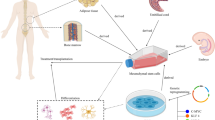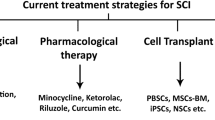Abstract
Objective
The aim of this study was to address the question of whether bone marrow-originated mononuclear cells (MNC) or mesenchymal stem cells (MSC) induce neural regeneration when implanted intraspinally.
Materials and Methods
The study design included 4 groups of mice: Group 1, non-traumatized control group; Groups 2, 3 and 4 spinal cord traumatized mice with 1 g force Tator clips, which received intralesionally either no cellular implants (Group 2), luciferase (Luc) (+) MNC (Group 3) or MSC (Group 4) obtained from CMV-Luc or beta-actin Luc donor transgenic mice. Following the surgery until decapitation, periodical radioluminescence imaging (RLI) and Basso Mouse Scale (BMS) evaluations was performed to monitor neural activity. Postmortem immunohistochemical techniques were used to analyze the fate of donor type implanted cells.
Results
All mice of Groups 3 and 4 showed various degrees of improvement in the BMS scores, whereas there was no change in Groups 1 and 2. The functional improvement was significantly better in Group 4 compared to Group 3 (18 vs 8, p = 0.002). The immunohistochemical staining demonstrated GFP+Luc+ neuronal/glial cells that were also positive with one or more of these markers: nestin, myelin associated glycoprotein, microtubule associated protein or myelin oligodendrocyte specific protein, which is considered as indicator of donor type neuronal regeneration. Frequency of donor type neuronal cells; Luc + signals and median BMS scores were observed 48–64 % and 68–72 %; 44–80 %; 8 and 18 within Groups III and IV respectively.
Discussion
MSCs were more effective than MNC in obtaining neuronal recovery. Substantial but incomplete functional improvement was associated with donor type in vivo imaging signals more frequently than the number of neuronal cells expressing donor markers in spinal cord sections in vitro. Our results are in favor of functional recovery arising from both donor MSC and MNCs, contributing to direct neuronal regeneration and additional indirect mechanisms.







Similar content being viewed by others
References
Duda, J., Karimi, M., Negrin, R. S. (2007). Methods for ımaging cells fates in hematopoiesis. In M. Beksac (Ed.), Bone marrow and stem cell transplantation (pp. 17–34).
Leeb, C., Jurga, M., McGuckin, C., Moriggl, R., & Kenner, L. (2010). Promising new sources for pluripotent stem cells. Stem Cell Reviews and Reports, 6(1), 15–26.
Rivlin, A. S., & Tator, C. H. (1978). Effect of duration of acute spinal cord compression in a new acute cord injury model in the rat. Surgical Neurology, 10(1), 39–43.
Zurita, M., Otero, L., Aguayo, C., Bonilla, C., Ferreira, E., Parajón, A., et al. (2010). Cell therapy for spinal cord repair: optimization of biologic scaffolds for survival and neural differentiation of human bone marrow stromal cells. Cytotherapy, 12(4), 522–537.
Pittenger, M. F., Mackay, A. M., Beck, S. C., Jaiswal, R. K., Douglas, R., Mosca, J. D., et al. (1999). Multilineage potential of adult human mesenchymal stem cells. Science, 284(5411), 143–147.
Parr, A. M., Tator, C. H., & Keating, A. (2007). Bone marrow-derived mesenchymal stromal cells for the repair of central nervous system injury. Bone Marrow Transplantation, 40(7), 609–619.
Wislet-Gendebien, S., Bruyère, F., Hans, G., Leprince, P., Moonen, G., & Rogister, B. (2004). Nestinpositive mesenchymal stem cells favour the astroglial lineage in neuralprogenitors and stem cells by releasing active BMP4. BMC Neuroscience, 15, 5–33.
Lee, J., Kuroda, S., Shichinohe, H., Ikeda, J., Seki, T., Hida, K., et al. (2003). Migration and differentiation of nuclear fluorescence-labeled bone marrow stromal cells after transplantation into cerebral infarct and spinal cord injury in mice. Neuropathology, 23(3), 169–180.
Yano, S., Kuroda, S., Lee, J. B., Shichinohe, H., Seki, T., Ikeda, J., et al. (2005). In vivo fluorescence tracking of bone marrow stromal cells transplanted into a pneumatic injury model of rat spinal cord. Journal of Neurotrauma, 22(8), 907–918.
Koda, M., Okada, S., Nakayama, T., Koshizuka, S., Kamada, T., Nishio, Y., et al. (2005). Hematopoietic stem cell and marrow stromal cell for spinal cord injury in mice. Neuroreport, 16(16), 1763–1767.
Wang, Y., Mah, N., Prigione, A., Wolfrum, K., Andrade-Navarro, M. A., & Adjaye, J. (2010). A transcriptional roadmap to the ınduction of pluripotency in somatic cells. Stem Cell Reviews and Reports, 6(2), 282–296.
Chopp, M., & Li, Y. (2002). Treatment of neural injury with marrow stromal cells. Lancet Neurology, 1(2), 92–100.
Wu, S., Suzuki, Y., Ejiri, Y., Noda, T., Bai, H., Kitada, M., et al. (2003). Bone marrow stromal cells enhance differentiation of cocultured neurosphere cells and promote regeneration of injured spinal cord. Journal of Neuroscience Research, 72(3), 343–351.
Scheper, W., & Copray, S. (2009). The molecular mechanism of ınduced pluripotency: a two-stage switch. Stem Cell Reviews and Reports, 5(3), 204–223.
Moviglia, G. A., Fernandez, V. R., Brizuela, J. A., Saslavsky, J., Vrsalovic, F., Varela, G., et al. (2006). Combined protocol of cell therapy for chronic spinal cord injury. Report on the electrical and functional recovery of two patients. Cytotherapy, 8(3), 202–209.
De Haro, J., Zurita, M., Ayllon, L., & Vaquero, J. (2005). Detection of 111 ınoxine-labeled bone marrow stromal cells after intravenous or intralesional administration in chronic paraplegic rats. Neuroscience Letters, 377(1), 7–11.
Vaquero, J., Zurita, M., Oya, S., & Santos, M. (2006). Cell therapy using bone marrow stromal cells in chronic paraplegic rats: systemic or local administration? Neuroscience Letters, 398(1–2), 129–134.
Deng, W., Obrocka, M., Fischer, I., & Prockop, D. J. (2001). In vitro differentiation of human marrow stromal cells into early progenitors of neural cells by conditions that increase intracellular cyclic AMP. Biochemical and Biophysical Research Communications, 282(1), 148–152.
Di Nicola, M., Carlo-Stella, C., Magni, M., Milanesi, M., Longoni, P. D., Matteucci, P., et al. (2002). Human bone marrow stromal cells suppress T-lymphocyte proliferation induced by cellular or nonspecific mitogenic stimuli. Blood, 99(10), 3838–3843.
Syková, E., & Jendlová, P. (2005). Magnetic resonance tracking of implanted adult and embryonic stem cells in injured brain and spinal cord. Annals of the New York Academy of Sciences, 1049, 146–160.
Wright, K. T., El Masri, W., Osman, A., Chowdhury, J., & Johnson, W. E. (2011). Concise review: bone marrow for the treatment of spinal cord injury: mechanisms and clinical applications. Stem Cells, 29(2), 169–178.
Hernándeza, J., Torres-Espína, A., & Navarro, X. (2011). Adult stem cell transplants for spinal cord injury repair: current state in preclinical research. Current Stem Cell Research & Therapy, 6(3), 273–287.
Dasari, V. R., Spomar, D. G., Cady, C., Gujrati, M., Rao, J. S., & Dinh, D. H. (2007). Mesenchymal stem cells from rat bone marrow downregulate caspase-3-mediated apoptotic pathway after spinal cord injury in rats. Neurochemical Research, 32(12), 2080–2093.
Frisen, J., Johansson, C. B., Torok, C., Risling, M., & Lendahl, U. (1995). Rapid, widespread, and longlasting induction of nestin contributes to the generation of glial scar tissue after CNS injury. The Journal of Cell Biology, 131(2), 453–464.
Sykova, E., Jendelova, P., Urdzikova, L., Lesný, P., & Hejcl, A. (2006). Bone marrow stem cells and polymer hydrogels-two strategies for spinal cord injury repair. Cellular and Molecular Neurobiology, 26(7–8), 1113–1129.
Himes, B. T., Neuhuber, B., Coleman, C., Kushner, R., Swanger, S. A., Kopen, G. C., et al. (2006). Recovery of function following grafting of human bone marrow-derived stromal cells into the injured spinal cord. Neurorehabilitation and Neural Repair, 20(2), 278–296.
Lois, C., Hong, E. J., Pease, S., et al. (2002). Germline transmission and tissue-specific expression of transgenes delivered by lentiviral vectors. Science, 295, 868–872.
Hakamata, Y., Tahara, K., Uchida, H., Sakuma, Y., Nakamura, M., Kume, A., et al. (2001). Green fluorescent proteintransgenic rat: a tool for organ transplantation research. Biochemical and Biophysical Research Communications, 286(4), 779–785.
Hadjantonakis, A. K., Gertsenstein, M., Ikawa, M., Okabe, M., & Nagy, A. (1998). Generating green fluorescent mice by germline transmission of green fluorescent ES cells. Mechanisms of Development, 76(1–2), 79–90.
Onifer, S. M., White, L. A., Whittemore, S. R., & Holets, V. R. (1993). In vitro labeling strategies for identifying primary neural tissue and a neuronal cell line after transplantation in the CNS. Cell Transplantation, 2(2), 131–149.
Parr, A. M., Kulbatski, I., Zahir, T., Wang, X., Yue, C., Keating, A., et al. (2008). Transplanted adult spinal cord-derived neural stem/progenitor cells promote early functional recovery after rat spinal cord injury. Neuroscience, 155(3), 760–770.
Vroemen, M., Aigner, L., Winkler, J., & Weidner, N. (2003). Adult neural progenitor cell grafts survive after acute spinal cord injury and integrate along axonal pathways. European Journal of Neuroscience, 18(4), 743–751.
Parr, A. M., Kulbatski, I., & Tator, C. H. (2007). Transplantation of adult rat spinal cord stem/progenitor cells for spinal cord injury. Journal of Neurotrauma, 24(5), 835–845.
Attar, A., Ayten, M., Ozdemir, M., Ozgencil, E., Bozkurt, M., Kaptanoglu, E., et al. (2011). An attempt to treat patients who have injured spinal cords with intralesional implantation of concentrated autologous bone marrow cells. Cytotherapy, 13(1), 54–60.
Inoue, H., Ohsawa, I., Murakami, T., Kimura, A., Hakamata, Y., Sato, Y., et al. (2005). Development of new inbred transgenic strains of rats with LacZ or GFP. Biochemical and Biophysical Research Communications, 329(1), 288–295.
Mujtaba, T., Han, S. S., Fischer, I., Sandgren, E. P., & Rao, M. S. (2002). Stable expression of the alkaline phosphatase marker gene by neural cells in culture and after transplantation into the CNS using cells derived from a transgenic rat. Experimental Neurology, 174(1), 48–57.
Prasher, D. C., Eckenrode, V. K., Ward, W. W., Prendergast, F. G., & Cormier, M. J. (1992). Primary structure of the Aequorea victoria green-fluorescent protein. Gene, 111(2), 229–233.
Ikawa, M., Tanaka, N., Kao, W. W., & Verma, I. M. (2003). Generation of transgenic mice using lentiviral vectors: a novel preclinical assessment of lentiviral vectors for gene therapy. Molecular Therapy, 8(4), 666–673.
Nakanishi, T., Kuroiwa, A., Yamada, S., Isotani, A., Yamashita, A., Tairaka, A., et al. (2002). FISH analysis of 142 EGFP transgene integration sites into the mouse genome. Genomics, 80(6), 564–574.
Tsien, R. Y. (1998). The green fluorescent protein. Annual Review of Biochemistry, 67, 509–544.
Mignone, J. L., Kukekov, V., Chiang, A. S., Steindler, D., & Enikolopov, G. (2004). Neural stem and progenitor cells in nestin-GFP transgenic mice. The Journal of Comparative Neurology, 469(3), 311–324.
Acknowledgment
This study was supported by grants from the Turkish Scientific Research Council TUBİTAK, Ankara University Research Resources (SBAG) and the Turkish Academy of Sciences.
Conflicts of Interest
The authors declare no potential conflicts of interest.
Author information
Authors and Affiliations
Corresponding authors
Rights and permissions
About this article
Cite this article
Ozdemir, M., Attar, A., Kuzu, I. et al. Stem Cell Therapy in Spinal Cord Injury: In Vivo and Postmortem Tracking of Bone Marrow Mononuclear or Mesenchymal Stem Cells. Stem Cell Rev and Rep 8, 953–962 (2012). https://doi.org/10.1007/s12015-012-9376-5
Published:
Issue Date:
DOI: https://doi.org/10.1007/s12015-012-9376-5




